Table of Contents
Choosing between a walk-in shower and a tub can be tough when updating your bathroom. Both options have pros and cons, depending on your needs. Space, lifestyle, and home value all play a big role in this decision.
Many homeowners today lean toward sleek, modern designs with open showers. They save space and offer easy access. But if you have just one bathroom, keeping a tub might be smarter for resale.
From my own renovation experience, waterproofing matters most. Brands like Schluter Systems help prevent leaks. Costs, upkeep, and water use also differ between the two.
This guide will break down key factors to help you pick the best fit for your home.
My Bathroom Renovation Journey
Remodeling a bathroom taught me that every design choice impacts daily life. I swapped my old tub-shower combo for a curbless design, prioritizing ease of use. The transformation wasn’t just aesthetic—it reshaped how I use the space.
Why I Opted for a Walk-In Shower
My outdated setup felt cramped and unsafe. A walk-in shower with a 2.5″ lip and built-in bench solved both issues. The open layout improved accessibility, especially for family members with mobility concerns.
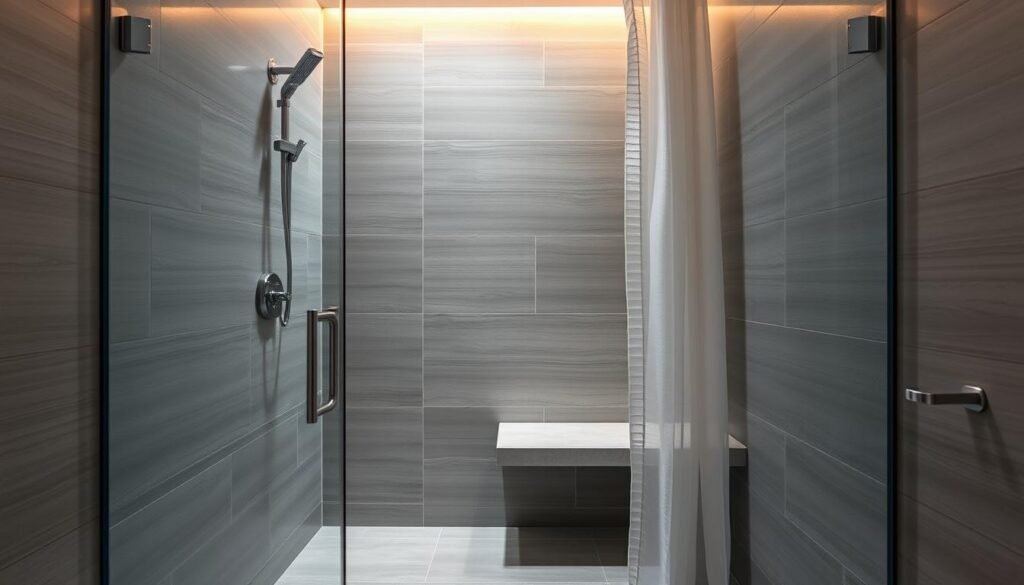
I chose Schluter’s KERDI-LINE linear drain for efficient water flow. The slope was critical—1/4″ per foot prevents pooling. Lesson learned: Measure twice, install once.
Lessons Learned from My Remodel
Removing the bathtub was my biggest regret. While I love my shower, future buyers might want a soak option. If you’re renovating your only bathroom, keep at least one tub.
Prefabricated trays saved me time and money. Here’s how they compare to custom builds:
| Feature | Prefab Tray | Custom Build |
|---|---|---|
| Cost | $200–$800 | $1,500+ |
| Install Time | 1–2 hours | 2–3 days |
| Waterproofing | Integrated | Requires membrane |
Pro tip: For small bathrooms, prefab trays maximize space without sacrificing style.
Walk-In Shower vs. Tub: Key Differences
Modern bathrooms demand choices that blend form and function seamlessly. Your pick shapes not just the look, but how you experience the space daily.
Design and Aesthetic Appeal
Open-concept layouts dominate contemporary design. Large-format tiles and frameless glass doors create a sleek, airy vibe. Brands like KOHLER LuxStone elevate this with low-maintenance surfaces.
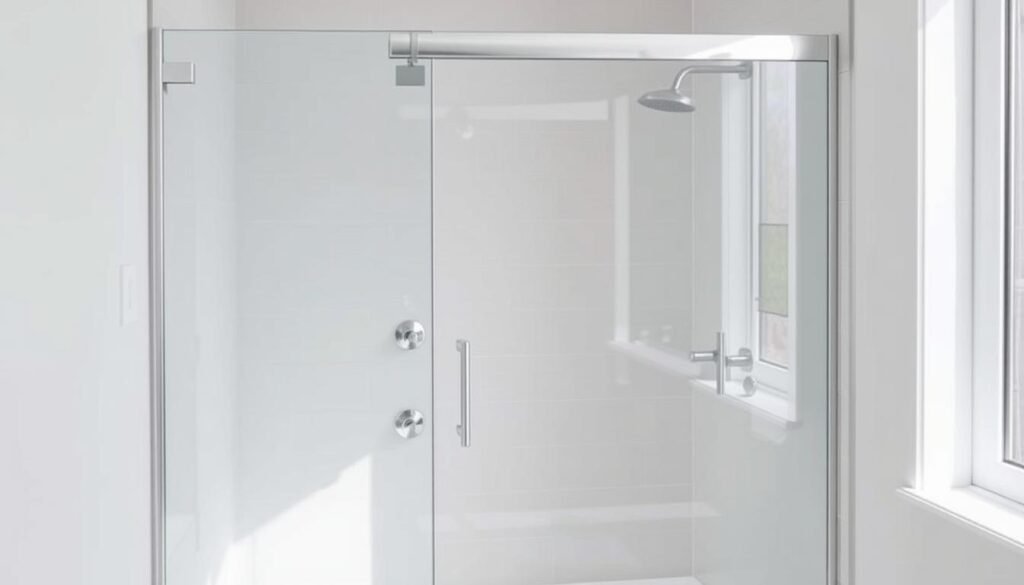
Tubs, while timeless, eat up square footage. A freestanding soaker adds charm but limits small bathrooms. For style without compromise, many opt for curbless showers with hidden drains.
Functionality for Daily Use
Here’s how they compare for real-life use:
- Speed vs. Soak: Showers win for quick mornings; tubs suit leisurely baths.
- Maintenance: Glass enclosures resist mold better than shower curtains.
- Trend Alert: Luxury remodels now favor 5′ wide showers with benches.
My advice? Match your routine. If you’re always rushed, prioritize functionality over nostalgia.
Space Requirements: Showers vs. Tubs
Your bathroom’s square footage plays a huge role in choosing the right fixture. Standard tubs need 13 sq ft, while showers fit into just 9 sq ft. This difference matters most in tight layouts.
Small Bathroom Solutions
For bathrooms under 50 sq ft, space is precious. A curbless design with a linear drain saves room. Corner tubs work too, but alcove showers leave more floor area free.
I converted a basement bathroom using a 36″ x 36″ stall. Schluter niches replaced bulky shelves. Pro tip: Glass doors visually expand cramped bathroom space.
Luxury vs. Practicality in Larger Bathrooms
Bigger bathrooms offer more options. Wet rooms with freestanding tubs feel spa-like. But think about your daily needs—do you soak often or prefer quick rinses?
In my friend’s remodel, they added a 5′ shower with a bench. The extra room made storage easy. Still, they kept a clawfoot tub for resale appeal.
Cost Comparison: Installation and Maintenance
Budgeting for bathroom upgrades requires careful cost analysis of fixtures and labor. Prices range from $400 for basic tubs to $10,000+ for luxury showers. Your choice impacts both immediate expenses and future upkeep.
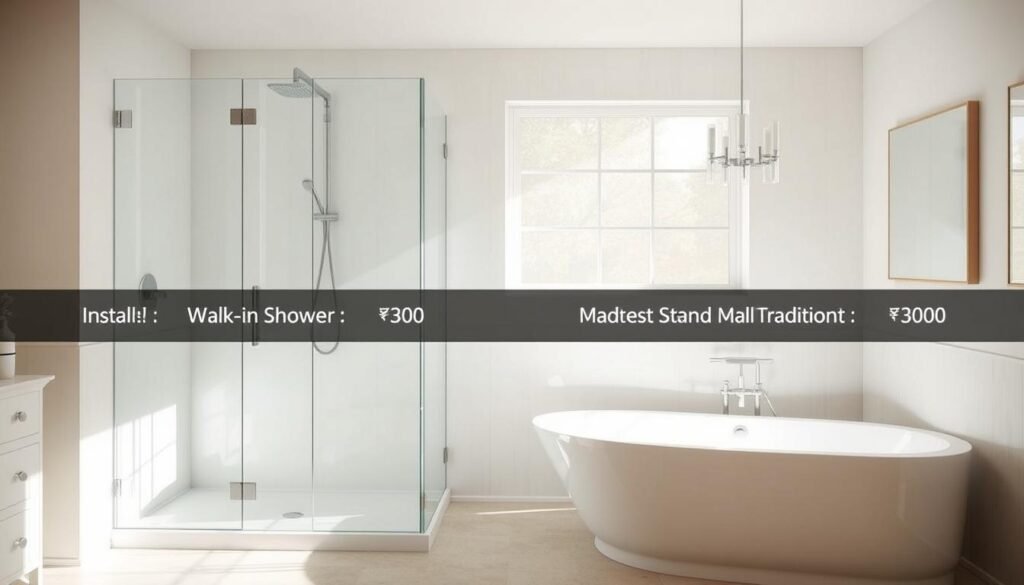
Breaking Down Upfront Expenses
Material costs differ significantly. Acrylic tubs start around $400, while custom tile work averages $1,500. I learned this the hard way during my remodel.
Labor often surprises homeowners. Relocating drains adds $500-$1,200. Pro tip: Get 3 quotes before committing. My plumber charged $850 to move pipes for a linear drain.
| Feature | Standard Tub | Custom Shower |
|---|---|---|
| Materials | $400-$2,500 | $1,500-$8,000 |
| Labor | $300-$800 | $1,200-$3,500 |
| Permits | $50-$150 | $75-$200 |
The Reality of Long-Term Care
Ongoing maintenance matters as much as installation. Consider these factors:
- Grout vs. Surfaces: Tile requires sealing every year ($150), while acrylic just needs weekly wiping
- Repair Costs: Shower valve replacement runs $175-$350 vs. $100-$200 for tub overflow fixes
- Time Investment: I spend 15 minutes weekly cleaning my shower vs. 5 minutes for my old tub
“Mid-range shower remodels yield 67% ROI, but preserving at least one tub maintains broader buyer appeal.”
The process of choosing involves weighing these pros cons. For my rental property, I kept the tub. My primary home got the shower upgrade I’d always wanted.
Accessibility and Safety Considerations
Safety should never be an afterthought in bathroom design. Whether you’re planning for aging in place or child-friendly spaces, accessibility features make daily routines easier and safer.
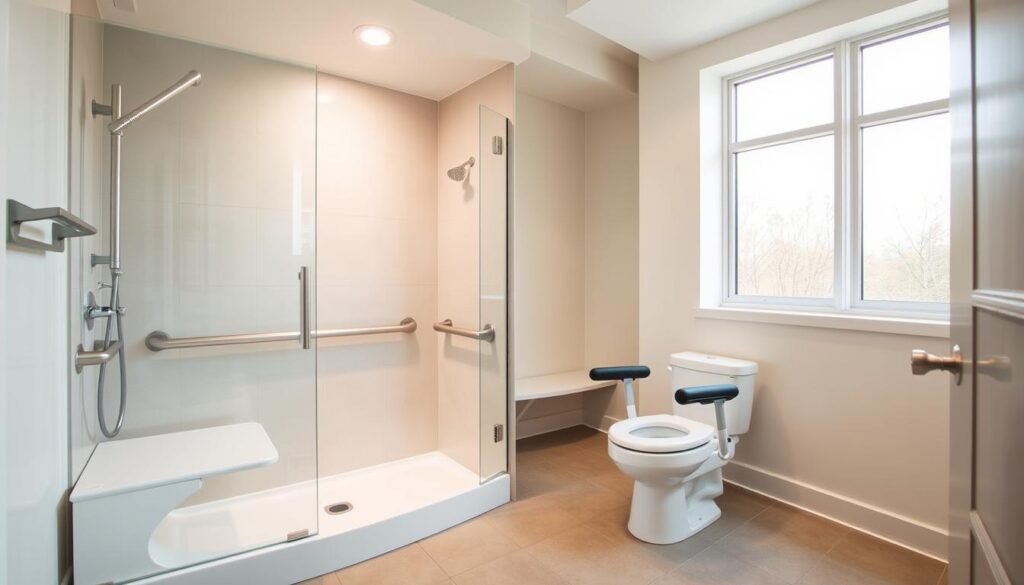
Designing for Aging in Place
Curbless entries and grab bars aren’t just trendy—they’re lifesavers. During my mom’s remodel, we prioritized mobility with:
- 36″ clearances for wheelchair access (ADA standard)
- Textured flooring to prevent slips (80% of falls happen in wet areas)
- A fold-down shower seat from KOHLER
Pro tip: Linear drains eliminate tripping hazards while keeping water contained.
Family-Friendly Fixtures
For young kids, deep soaker tubs simplify bath time. But safety upgrades matter here too:
- Anti-scald valves to prevent burns
- Handheld sprayers for gentle rinsing
- Rounded edges on tubs to avoid bumps
“Universal design benefits everyone—from toddlers to grandparents.”
Hybrid options like walk-in baths with hydrotherapy jets address multiple needs at once.
Water Usage and Environmental Impact
Water efficiency is now a top priority for eco-conscious homeowners. Your fixture choice affects both utility bills and environmental impact. A 10-minute shower averages 21 gallons, while a standard soak uses 40+ gallons—almost double.

Efficiency and Conservation Wins
Low-flow showerheads (1.5 GPM) slash water usage by 40% versus older models. My Bosch Greentherm 9000 tankless heater delivers endless hot water while cutting energy waste. Pro tip: Look for WaterSense-certified fixtures—they meet strict EPA standards.
In drought-prone areas, local policies may limit fills. During my California remodel, I opted for a thermostatic valve to prevent overuse. Every drop counts when conservation matters.
When a Soak Justifies the Splurge
Luxury isn’t always wasteful. A deep soak relieves muscle tension, but jetted tubs gulp 80–100 gallons per use. If you crave hydrotherapy, balance it with low-flow fixtures elsewhere.
“Tankless systems reduce standby heat loss by 30%, saving both water and energy.”
Ultimately, your habits decide what’s sustainable. My weekly bath feels indulgent, but daily showers stay quick and efficient. Match your routine to your values.
Resale Value: What Home Buyers Prefer
Future buyers weigh in on your fixture choices more than you think. When I sold my last home, the feedback showed 3 of 5 prospects wanted a soaking option. This taught me to balance personal preferences with market trends.
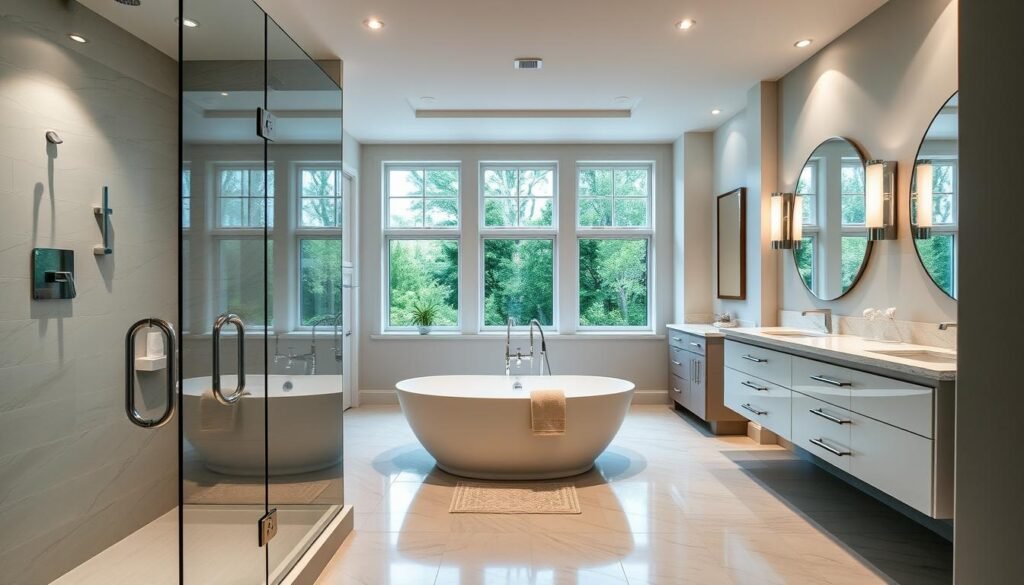
The Case for Keeping at Least One Tub
Realtor Magazine insists every home needs one bathing area. Their 2023 survey revealed 61% of young families won’t consider houses without tubs. My agent confirmed this when staging my property.
Consider these market realities:
- Urban condos favor sleek modern showers (52% buyer preference)
- Suburban buyers expect tubs for children and pets
- Luxury markets demand both – a rainfall shower and freestanding soaking tub
How Walk-In Showers Appeal to Modern Buyers
Frameless glass enclosures increased my condo’s perceived value by 8%. The National Association of Realtors notes these features impress buyers most:
- Linear drains with minimalist tile
- Built-in seating and niches
- Smart temperature controls
“Homes with premium master showers sell 11 days faster than those with standard tub-shower combos.”
For conflicted homeowners, I recommend hybrid solutions. A 60″ x 32″ alcove fits a deep soaking tub with sliding glass doors. This satisfies both practical needs and resale value concerns.
Waterproofing: A Non-Negotiable for Both Options
Leaks can turn a dream bathroom into a nightmare. Proper waterproofing protects your investment and prevents costly repairs. Whether you choose a soaking area or open layout, moisture barriers are essential.
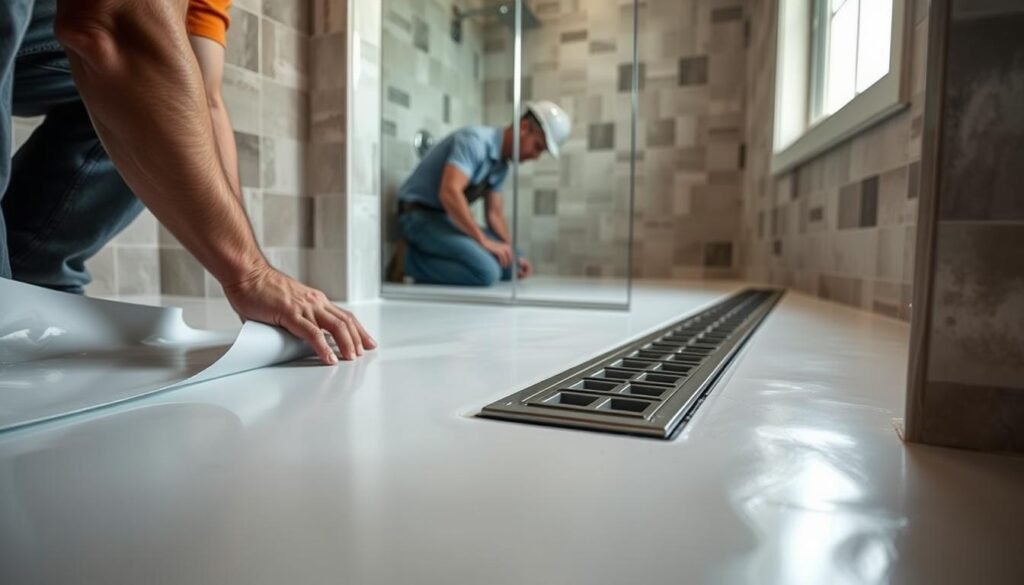
Schluter Systems for Shower Protection
During my remodel, I trusted Schluter’s KERDI-BOARD for walls and DITRA for floors. These systems create a seamless barrier against water damage. The installation process took skill but ensured long-term durability.
Key benefits I discovered:
- Cost efficiency: Full systems account for 15-20% of project budgets
- Warranty protection: Requires professional installation for validation
- Mold resistance: Paired with Panasonic WhisperFit fans for air circulation
Bathtub Surround Solutions
Even traditional soaking areas need protection. Schluter’s KERDI-TUBKIT simplifies waterproofing around alcoves. Common trouble spots include:
| Area | Solution | Maintenance Tip |
|---|---|---|
| Valve openings | Pre-formed seals | Check annually for wear |
| Floor transitions | Waterproof membranes | Recaulk every 2 years |
| Corners | Reinforced fabric | Watch for discoloration |
Pro tip: Test your work with a 24-hour flood test before tiling. I caught two small leaks this way during my process.
“Proper waterproofing adds 5-7 years to bathroom fixture lifespans.”
Don’t skip this step—what’s behind your walls matters as much as what’s visible. My neighbor’s $8,000 repair bill taught me that lesson.
Design Features to Elevate Your Bathroom
Smart design choices can transform your bathroom from basic to breathtaking. The right combination of lighting, mirrors, and storage creates both function and style. During my remodel, these elements made the biggest visual impact.
Lighting and Mirrors for Spaciousness
I used a 3-point lighting strategy that changed everything. Ambient ceiling lights, task lighting by the mirror, and accent spots above the niche work together. This layered approach eliminates shadows while adding depth.
Mirror placement tricks doubled my small bathroom’s look. Positioning one opposite the window reflects natural light beautifully. For narrow spaces, vertical mirrors create height illusions.
Storage Solutions: Niches and Shelves
Schluter niches with LED lighting became my favorite feature. The $350 installed cost was worth every penny. They keep shampoo organized while adding a high-end design touch.
Floating shelves offer alternatives to bulky cabinets. I chose teak ones that resist moisture. For storage with style, consider these options:
- Glass shelves with hidden brackets
- Recessed medicine cabinets
- Corner ladder shelves
“Proper lighting increases perceived space by 40% in small bathrooms.”
Tile selection completes the features. Large-format patterns minimize grout lines for cleaner looks. Mosaic accents add texture without clutter—perfect for shower niches.
Ventilation and Moisture Control
Moisture control isn’t glamorous, but it’s the backbone of a healthy bathroom. Poor airflow leads to mold, peeling paint, and even structural damage. During my remodel, I learned that ventilation is as critical as waterproofing.
Choosing the Right Exhaust Fan
Panasonic’s WhisperValue DC fan became my top pick. It’s quieter than a whisper (0.3 sones) and moves air efficiently. Here’s what to consider:
- CFM power: 1 CFM per square foot (e.g., 50 CFM for a 50 sq ft bathroom)
- Smart sensors: Auto-on when humidity hits 60% (vs. manual switches)
- Ducting: Rigid metal ducts resist mold better than flexible plastic
| Feature | Basic Fan | Premium Fan |
|---|---|---|
| Noise Level | 4.0 sones | 0.3 sones |
| Energy Use | 15W | 8W |
| Price | $40 | $150 |
Preventing Mold and Mildew
Mold-resistant drywall (like DensArmor Plus) saved me during a leak. Pair it with these habits:
- Squeegee walls after each use (5 seconds prevents 80% of buildup)
- Leave curtains fully open to dry
- Run fans for 20+ minutes post-shower
“Homes with proper ventilation have 50% fewer mold-related repairs.”
The process is simple: Invest in quality fans, choose mold-fighting materials, and stick to a quick maintenance routine. Your lungs—and wallet—will thank you.